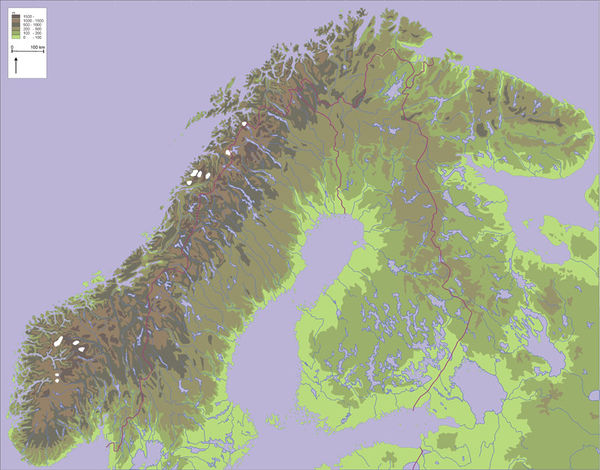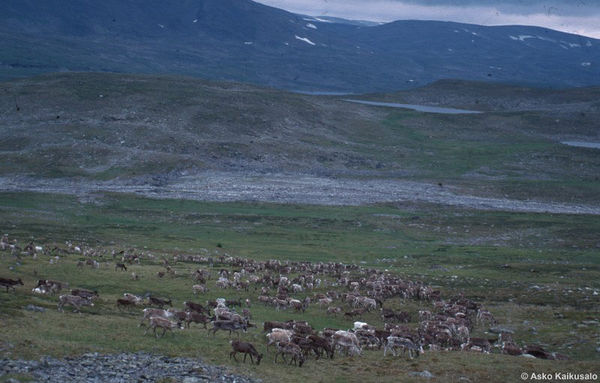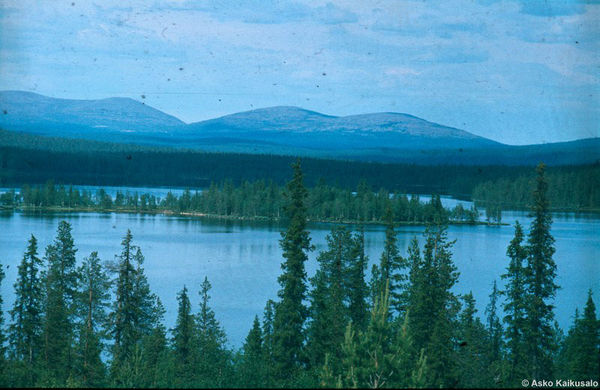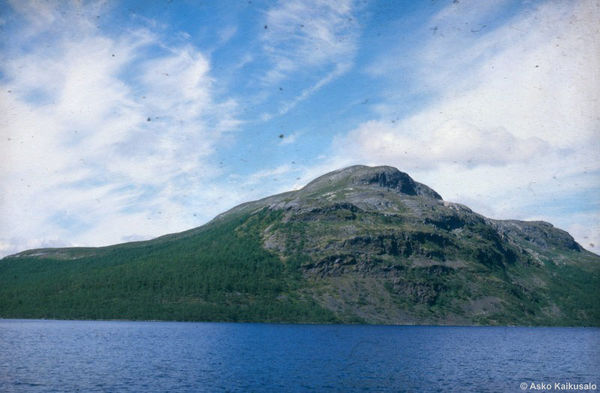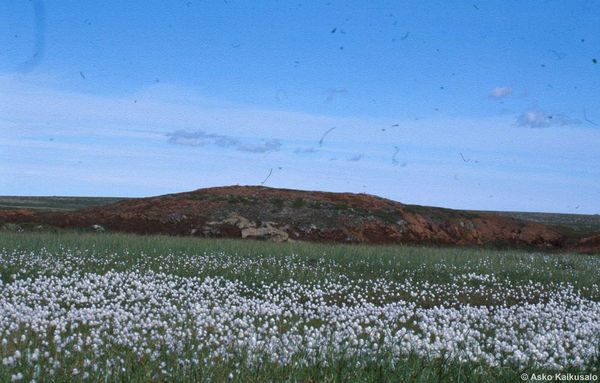Nature in the North
{{Artikkeli |sivun nimi=Nature in the North |kieli=englanti |id=0801
|artikkeliteksti=Nature is the entity composed of flora, fauna and micro-organisms together with the landscape (fells, rivers, etc.), and is also the habitat of man. The northern regions have a unique natural environment. (
)kuvat/Kartat/Paikat/davvin2.jpg Sápmi relief
Administratively, Finnish Lapland consists of the Province of Lapland. It extends from the end of the Gulf of Bothnia to Kilpisjärvi and Utsjoki, an area of almost 100,000 square kilometres. The area is the home of about 200,000 persons and reindeer, that is about two creatures per square kilometre. In terms of natural geography, however, Lapland as a whole is more than the Finnish Province of Lapland because outside the borders of Finland it also extends into Sweden in the Province of Norrbotten, into Norway in the Provinces of Tromso and Finnmark and into the Russian Republic in the Kola Peninsula. Lapland and the area of Saami culture extend along the Kolen Mountains as far south as latitude 62º N.
The network of nature conservation areas consists mainly in national and nature parks. The largest national parks in Finnish Lapland are the Lemmenjoki National Park and the Urho Kekkonen National Park. The large number of protected areas has caused disputes over land use in Lapland. However, over the last few decades people have come to see the value of the protected areas in a new light as they have become the region's biggest tourist attraction. Apart from the national parks, there are also more wildernesses in Lapland than elsewhere in Finland. The wilds are not nature conservation areas as such, although the aim is to conserve their (roadless) nature as wildernesses. They are also important as pasturages for reindeer (
). kuvat/Kaikusalo/Poro.jpg Reindeer herdThe area today inhabited by Finnish Saami people can be roughly divided into two parts: Forest Lapland and Fell Lapland, with a natural border created by the northern limit of the conifer belt and the forests (flora). The pine forest line meanders along the contours of the terrain in Finland from Karesuvanto in the west to north of the River Näätämöjoki in the east. Forest Lapland is part of the taiga, a swampy coniferous belt stretching across Lapland (
).kuvat/Kaikusalo/Pallas.jpg
A belt of mountain birch stands forms an intervening zone between the taiga and the treeless tundra (duottar). Fell Lapland consists of this belt of mountain birches (picture)() (kuvat/Kaikusalo/Pikku-malla2.jpg Pikku-Malla), which grow to a height of 5-10 metres and the bare slopes of the fells. Almost everywhere else in the world, it is conifers that constitute the tree line. In western Lapland the mountain birch forest line is about 600 metres above sea level and in eastern Lapland about 400 metres. It is not until an altitude of about 900 1000 metres that forest undergrowth plants like bilberries no longerthrive. In Forest Lapland, too, there are some individual fells (e.g. Ylläs, Levi, Pallas-Ounas, Sokosti, Kiilopää and Värriö Fells) of the type found in Fell Lapland, with exceptionally high peaks rising out of the forests.The nature of Lapland is characterized by great differences in seasonal change. The long, cold, snowy winter begins in October and ends in late March, the short, rushing spring changes at the end of May into a brief, light but cold summer, and by the end of August the signs of autumn are already visible. The average annual temperature determines the length of the growing season in different areas and thus the polymorphism of the flora and its division into zones. Generally conditions become harsher towards the north. For example, in Forest Lapland the average annual temperature is +1 -1ºC, while in Fell Lapland it is -1 -2.5ºC. In Kilpisjärvi the average temperature of the hottest month of the year, July, is below +11ºC. Thanks to the Gulf Stream, however, Lapland is considerably warmer in winter than interior parts of continental Russia and Canada at the same latitude. Roughly speaking, the population of living organisms in the north is poor in terms of the number of species and sparse in size per unit of land area
(fauna). For example, where as in southern Finland there grow about 950 varieties of vascular plants, in both Enontekiö and Inari in Lapland the equivalent number is about 450.
There is less of Fell Lapland proper, where conifer trees have disappeared altogether, in Finland than in her neighbouring countries. In western Finnish Lapland, it begins north of the villages of Kuttunen and Leppäjärvi, and in eastern Lapland it starts from the village of Kaamanen. Apart from the areas around Lake Kilpisjärvi and Haltti, in which there are dozens of fells rising over 1000 metres (the highest being Haltti Fell 1328 m, picture), Fell Lapland generally has gently rolling contours. The eastern and northern slopes of the big fells of the 'Arm of Finland' (the northwestern strip of territory projecting into Norway) still have patches of snow on them even at the end of summer (picture) , although there are no areas in Finland that are for ever covered with snow and ice. Even though the bare upland region in Finland is relatively small in area, the communities of living organisms in the fells constitute an important part of the variety of nature in Finland. A particularly large number of beautiful plants grow on the fells, and they are an important tourist attraction as is also the bird life there.
The bare upland area is varied. There are lush meadows in July and August where there grows a wide range of relatively low-growing plants, while the more barren moors of the fells are covered with lichen and twigs, and in the most desolate parts of all there is nothing but rocks (picture). The meadows are usually situated on the lower slopes of the fells, and they are the first to shed their covering of snow and offer the reindeer some fresh spring vegetation after the winter. Apart from the birch shoots and leaves, the reindeer eat the boletus fungi that grow in a symbiotic relationship with the birches. The Saami have traditionally lived on the border between the mountain birch belt and the open fells, moving each side of this line according to the season. Ecologically, they could be described as a tree line people.
In addition to the conifer forests and bare fells, Lapland is characterized by swamps and flowing waters (picture), from big rivers to small streams, which are often covered or fringed by stands of mountain birches or willow thickets (ecology). There are numerous fast-flowing rivers: Torniojoki, Tenojoki, Ounasjoki, Kemijoki, and so on. Apart from artificial reservoirs, there are few large lakes in Finnish Lapland. The best known are Inarijärvi in the east and Kilpisjärvi in the west. The swamps of Lapland are generally broad, open marshy tracts (áhpi). In addition to these there are also palsa bogs, in which an exceptionally large number of bird species nest, in particular waders. These peat bogs are also abundant in cloudberries. In the palsas, watery hollows alternate with huge turf mounds (often up to seven metres high), which, apart from an unfrozen half-metre deep superficial layer, are in the grip of the permafrost. The oldest palsas in Lapland are about 3000 years old. Apart from the cores of the palsas (
